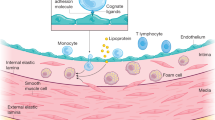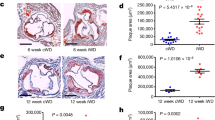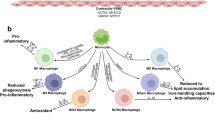Abstract
Atherosclerosis, a disease of the large arteries, is the primary cause of heart disease and stroke. In westernized societies, it is the underlying cause of about 50% of all deaths. Epidemiological studies have revealed several important environmental and genetic risk factors associated with atherosclerosis. Progress in defining the cellular and molecular interactions involved, however, has been hindered by the disease's aetiological complexity. Over the past decade, the availability of new investigative tools, including genetically modified mouse models of disease, has resulted in a clearer understanding of the molecular mechanisms that connect altered cholesterol metabolism and other risk factors to the development of atherosclerotic plaque. It is now clear that atherosclerosis is not simply an inevitable degenerative consequence of ageing, but rather a chronic inflammatory condition that can be converted into an acute clinical event by plaque rupture and thrombosis.
This is a preview of subscription content, access via your institution
Access options
Subscribe to this journal
Receive 51 print issues and online access
$199.00 per year
only $3.90 per issue
Buy this article
- Purchase on SpringerLink
- Instant access to full article PDF
Prices may be subject to local taxes which are calculated during checkout







Similar content being viewed by others
References
Tamminen, M., Mottino, G., Qiao, J. H., Breslow, J. L. & Frank, J. S. Ultrastructure of early lipid accumulation in apoE-deficient mice. Arterioscl. Thromb. Vasc. Biol. 19, 847–853 (1999).
Ross, R. The pathogenesis of atherosclerosis: a perspective for the 1990s. Nature 362, 801–809 ( 1993).
Libby, P. Changing concepts of atherogenesis. J. Intern. Med. 247, 349–358 (1999).
Mehrabian, M., Wen, P.-Z., Fisler, J., Davis, R. C. & Lusis, A. J. Genetic loci controlling body fat, lipoprotein metabolism, and insulin levels in a multifactorial mouse model. J. Clin. Invest. 101, 2485–2496 ( 1998).
Lusis, A. J., Weinreb, A. & Drake, T. A. in Textbook of Cardiovascular Medicine (ed. Topol, E. J.) 2389–2413 (Lippincott-Raven, Philadelphia, 1998).
Goldbourt, U. & Neufeld, H. N. Genetic aspects of arteriosclerosis . Arteriosclerosis 6, 357– 377 (1988).
Smithies, O. & Maeda, N. Gene targeting approaches to complex diseases: atherosclerosis and essential hypertension. Proc. Natl Acad. Sci. USA 92, 5266–5272 (1995).
Gimbrone, M. A. Jr Vascular endothelium, hemodynamic forces, and atherogenesis . Am. J. Pathol. 155, 1– 5 (1999).
Boren, J. et al. Identification of the principal proteoglycan-binding site in LDL. A single-point mutation in apo-B100 severely affects proteoglycan interaction without affecting LDL receptor binding. J. Clin. Invest. 101, 2658–2664 (1998).
Grainger, D. J., Kemp, P. R., Liu, A. C., Lawn, R. M. & Metcalfe, J. C. Activation of transforming growth factor-β is inhibited in transgenic apolipoprotein(a) mice. Nature 370, 460–462 (1994).
Goldstein, J. L., Ho, Y. K., Basu, S. K. & Brown, M. S. Binding sites on macrophages that mediate uptake and degradation of acetylated low density lipoprotein, producing massive cholesterol deposition. Proc. Natl Acad. Sci. USA 76, 333–337 (1979).
Cyrus, T. et al. Disruption of 12/15-lipoxygenase diminishes atherosclerosis in apoE-deficient mice. J. Clin. Invest. 103, 1597–1604 (1999).
Hegele, R. A. Paraoxonase–genes and disease. Ann. Med. 31, 217–224 (1999).
Shih, D. M. et al. Combined serum paraoxonase knockout/apolipoprotein E knockout mice exhibit increased lipoprotein oxidation and atherosclerosis. J. Biol. Chem. 276, 17527–17535 (2000).
Watson, A. D. et al. Structural identification by mass spectrometry of oxidized phospholipids in minimally oxidized low density lipoprotein that induce monocyte/endothelial interactions and evidence for their presence in vivo. J. Biol. Chem. 272, 13597–13607 (1997).
Knowles, J. W. et al. Enhanced atherosclerosis and kidney dysfunction in eNOS(−/−) apoE(−/−) mice are ameliorated by enalapril treatment. J. Clin. Invest. 105, 451–458 (2000).
Hofmann, M. A. et al. RAGE mediates a novel proinflammatory axis: a central surface receptor for S100/calgranulin polypeptides. Cell 97 , 889–901 (1999).
Dong, Z. M. et al. The combined role of P- and E-selectins in atherosclerosis . J. Clin. Invest. 102, 145– 152 (1998).
Collins, R. G. et al. P-selectin or intercellular adhesion molecule (ICAM-1) deficiency substantially protects against atherosclerosis in apolipoprotein E-deficient mice. J. Exp. Med. 191, 189– 194 (2000).
Shih, P. T. et al. Blocking very late antigen-4 integrin decreases leukocyte entry and fatty streak formation in mice fed an atherogenic diet. Circ. Res. 84, 345–351 ( 1998).
Gu, L. et al. Absence of monocyte chemoattractant protein-1 reduces atherosclerosis in low density lipoprotein-deficient mice. Mol. Cell 2, 275–281 (1998).
Boring, L., Gosling, J., Cleary, M. & Charo, I. F. Decreased lesion formation in CCR2−/− mice reveals a role for chemokines in the initiation of atherosclerosis. Nature 394, 894–897 (1998).
Smith, J. D. et al. Decreased atherosclerosis in mice deficient in both macrophage colony-stimulating factor (op) and apolipoprotein E. Proc. Natl Acad. Sci. USA 92, 8264–8268 (1995).
Podrez, E. A. et al. Macrophage scavenger receptor CD36 is the major receptor for LDL modified by monocyte-generated reactive nitrogen species. J. Clin. Invest. 105, 1095–1108 (2000).
Marathe, S., Kuriakose, G., Williams, K. J. & Tabas, I. Sphingomyelinase, an enzyme implicated in atherogenesis, is present in atherosclerotic lesions and binds to specific components of the subendothelial extracellular matrix. Arterioscl. Thromb. Vasc. Biol. 19, 2648–2658 (1999).
Ivandic, B. et al. Role of group II secretory phospholipase A2 in atherosclerosis I. Increased atherogenesis and altered lipoproteins in transgenic mice expressing group IIa phospholipase A2 . Arterioscl. Thromb. Vasc. Biol. 19, 1284–1290 (1999).
Suzuki, H. et al. A role for macrophage scavenger receptors in atherosclerosis and susceptibility to infection. Nature 386, 292–296 (1997).
Febbraio, M. et al. Targeted disruption of the class B scavenger receptor CD36 protects against atherosclerosis lesion development in mice. J. Clin. Invest. 105, 1049–1056 (2000).
Tontonoz, P., Nagy, L., Alvarez, J. L., Thomazy, V. A. & Evans, R. M. PPAR gamma promotes monocyte/macrophage differentiation and uptake of oxidized LDL. Cell 93, 241 –252 (1998).
Fazio, S. et al. Increased atherogenesis in mice reconstituted with apolipoprotein E null macrophages. Proc. Natl Acad. Sci. USA 94, 4647–4652 (1997).
Accad, M. et al. Massive xanthomatosis and altered composition of atherosclerotic lesions in hyperlipidemic mice lacking acyl CoA:cholesterol acyltransferase 1. J. Clin. Invest. 105, 711– 719 (2000).
Schönbeck, U., Sukhova, G. K., Shimizu, K., Mach, F. & Libby, P. Inhibition of CD40 signaling limits evolution of established atherosclerosis in mice. Proc. Natl Acad. Sci. USA 97, 7458–7463 ( 2000).
Fyfe, A. I., Qiao, J. H. & Lusis, A. J. Immune deficient mice develop typical atherosclerotic fatty streaks when fed an atherogenic diet. J. Clin. Invest. 94, 2516–2520 (1994).
Shaw, P. X. et al. Natural antibodies with T15 idiotype may act in atherosclerosis apoptotic clearance and protective immunity. J. Clin. Invest. 105, 1731–1740 (2000).
Gupta, S. et al. IFN-γ potentiates atherosclerosis in apoE knock-out mice . J. Clin. Invest. 99, 2752– 2761 (1997).
Gerhard, G. T. & Duell, P. B. Homocysteine and atherosclerosis. Curr. Opin. Lipidol. 10, 417–429 (1999).
Negoro, N. et al. Blood pressure regulates platelet-derived growth factor A-chain gene expression in vascular smooth muscle cells in vivo. An autocrine mechanism promoting hypertensive vascular hypertrophy. J. Clin. Invest. 95, 1140–1150 ( 1995).
Nathan, L. & Chaudhuri, G. Estrogens and atherosclerosis . Annu. Rev. Pharmacol. Toxicol. 37, 477 –515 (1997).
Streblow, D. N. et al. The human cytomegalovirus chemokine receptor US28 mediates vascular smooth muscle cell migration. Cell 99, 511–520 (1999).
Guevara, N. V., Kim, H.-S., Antonova, E. L. & Chan, L. The absence of p53 accelerates atherosclerosis by increasing cell proliferation in vivo. Nature Med. 5, 335– 339 (1999).
Schwartz, S. M. & Murray, C. E. Proliferation and the monoclonal origin of atherosclerotic lesions. Annu. Rev. Med. 49, 437–460 ( 1998).
Watson, K. E. et al. TGF-β1 and 25-hydroxycholesterol stimulate osteoblast-like vascular cells to calcify. J. Clin. Invest. 93, 2106–2113 (1994).
Moultan, K. S. & Folkman, J. in Molecular Basis of Cardiovascular Disease (ed. Chien, K. R.) 393– 410 (Saunders, Philadelphia, 1999).
Schonbeck, U. et al. CD40 ligation induces tissue factor expression in human vascular smooth muscle cells. Am. J. Pathol. 156, 7–14 (2000).
Young, S. G. & Fielding, C. J. The ABCs of cholesterol efflux . Nature Genet. 22, 316– 318 (1999).
Orsó, E. et al. Transport of lipids from Golgi to plasma membrane is defective in Tangier disease patients and ABC1-deficient mice. Nature Genet. 24, 192–196 ( 2000).
Geller, D. S. et al. Activating mineralocorticoid receptor mutation in hypertension exacerbated by pregnancy. Science 289, 119 –123 (2000).
Cargill, M. et al. Characterization of single-nucleotide polymorphisms in coding regions of human genes. Nature Genet. 22, 231–238 (1999).
Krushkal, J. et al. Genome-wide linkage analyses of systolic blood pressure using highly discordant siblings. Circulation 99, 1407–1410 (1999).
Stoll, M. et al. New target regions for human hypertension via comparative genomics . Genome Res. 10, 473–482 (2000).
Aitman, T. J. et al. Identification of CD36 (Fat) as an insulin-resistance gene causing defective fatty acid and glucose metabolism in hypertensive rats. Nature Genet. 21, 76–83 (1999).
Shi, W., Haberland, M. E., Jien, M. L., Shih, D. M. & Lusis, A. J. Endothelial responses to oxidized lipoproteins determine genetic susceptibility to atherosclerosis in mice. Circulation 102, 75–81 ( 2000).
Risch, N. J. Searching for genetic determinants in the new millennium. Nature 405, 847–856 ( 2000).
Assmann, G., Cullen, P., Jossa, F., Lewis, B. & Mancini, M. Coronary heart disease: reducing the risk. Arterioscl. Thromb. Vasc. Biol. 19, 1819– 1824 (1999).
Navab, M. et al. The yin and the yang of oxidation in the development of the fatty streak. A review based on the 1994 George Lyman Duff Memorial Lecture. Arterioscl. Thromb. Vasc. Biol. 16, 831– 842 (1996).
Desumont, C. et al. Complete atherosclerosis regression after human apoE gene transfer in apoE deficient/nude mice. Arterioscl. Thromb. Vasc. Biol. 20, 435–442 ( 2000).
Herrera, V. L. et al. Spontaneous combined hyperlipidemia, coronary heart disease and decreased survival in Dahl salt-sensitive hypertensive rats transgenic for human cholesteryl ester transfer protein. Nature Med. 5, 1383–1389 (1999).
Gordon, D. J. & Rifkind, B. M. High-density lipoprotein—the clinical implications of recent studies. N. Engl. J. Med. 321, 1311–1316 (1989).
Kronenberg, F. et al. Role of lipoprotein(a) and apolipoprotein(a) phenotype in atherogenesis. Circulation 100, 1154– 1160 (1999).
Luft, F. C. Molecular genetics of human hypertension. J. Hypertens. 16, 1871–1878 (1998).
Glassman, A. H. & Shapiro, P. A. Depression and the course of coronary artery disease. Am. J. Psychiatry 155, 4–11 (1998).
Kugiyama, K. et al. Circulating levels of secretory type II phospholipase A 2 predict coronary events in patients with coronary artery disease. Circulation 100, 1280–1284 (1999).
Steinberg, D. & Witztum, J. L. in Molecular Basis of Cardiovascular Disease (ed. Chien, K. R.) 458–475 (Saunders, Philadelphia, 1999).
Hu, H., Pierce, G. N. & Zhong, G. The atherogenic effects of chlamydia are dependent on serum cholesterol and specific to Chlamydia pneumoniae. J. Clin. Invest. 103, 747–753 (1999).
Cohen, J. C., Wang, Z., Grundy, S. M., Stoesz, M. R. & Guerra, R. Variation at the hepatic lipase and apolipoprotein AI/CIII/AIV loci is a major cause of genetically determined variation in plasma HDL cholesterol levels. J. Clin. Invest. 94, 2377– 2384 (1994).
Wittrup, H. H., Tybjaerg-Hansen, A. & Nordestgaard, B. G. Lipoprotein lipase mutations, plasma lipids and lipoproteins, and risk of ischemic heart disease: a meta-analysis . Circulation 99, 2901– 2907 (1999).
Samani, N. J., Thompson, J. R., O'Toole, L., Channer, K. & Woods, K. L. A meta-analysis of the association of the deletion allele of the antiogensin-converting enzyme gene with myocardial infarction. Circulation 94, 708– 712 (1996).
Tuomainen, T.-P. et al. Increased risk of acute myocardial infarction in carriers of the hemachromatosis gene Cys282 Tyr mutation. Circulation 100, 1274–1279 (1999).
Hingorani, A. D. et al. A common variant of the endothelial nitric oxide synthase (Glu298 → Asp) is a major risk factor for coronary artery disease in the UK. Circulation 100, 1515– 1520 (1999).
Franco, R. F. et al. Factor XIII and the risk of myocardial infarction. Haematologica 85, 67–71 (2000).
Nievelstein-Post, P., Mottino, G., Fogelman, A. & Frank, J. An ultrastructural study of lipoprotein accumulation in cardiac valves of the rabbit. Arterioscl. Thromb. Vasc. Biol. 14, 1151–1161 (1994).
Nievelstein, P. F., Fogelman, A. M., Mottino, G. & Frank, J. S. Lipid accumulation in rabbit aorta intima 2 hours after bolus infusion of low density lipoprotein. A deep-etch and immunolocalization study of ultrarapidly frozen tissue. Arterioscl. Thromb. Vasc. Biol. 11, 1795–1805 (1991).
Acknowledgements
I thank R. Chen and K. Wong for help with the preparation of this manuscript and L. Olson for help with the illustrations. Work in my laboratory was supported by NIH grants.
Author information
Authors and Affiliations
Corresponding author
Rights and permissions
About this article
Cite this article
Lusis, A. Atherosclerosis. Nature 407, 233–241 (2000). https://doi.org/10.1038/35025203
Issue Date:
DOI: https://doi.org/10.1038/35025203
This article is cited by
-
Pelargonidin alleviates acrolein-induced inflammation in human umbilical vein endothelial cells by reducing COX-2 expression through the NF-κB pathway
Naunyn-Schmiedeberg's Archives of Pharmacology (2024)
-
A systematic review and meta-analysis of circulating adhesion molecules in rheumatoid arthritis
Inflammation Research (2024)
-
Role of sirtuins in attenuating plaque vulnerability in atherosclerosis
Molecular and Cellular Biochemistry (2024)
-
Associations of time-weighted individual exposure to ambient particulate matter with carotid atherosclerosis in Beijing, China
Environmental Health (2023)
-
Estimating the role of single-nucleotide polymorphism (rs1800629)-308 G/A of TNF-alpha gene as genetic marker associated with angina pectoris in a sample of Iraqi patients
Journal of Genetic Engineering and Biotechnology (2023)



